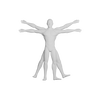Articles
Contact
Drag over the contact form
Let's get in touch
Want to discuss your sports massage or your injury? Contact us on the details below:
Contact details
200 Morrison StreetEdinburgh EH3 8EB
info@sportstherapyedinburgh.uk
0131 235 1001
